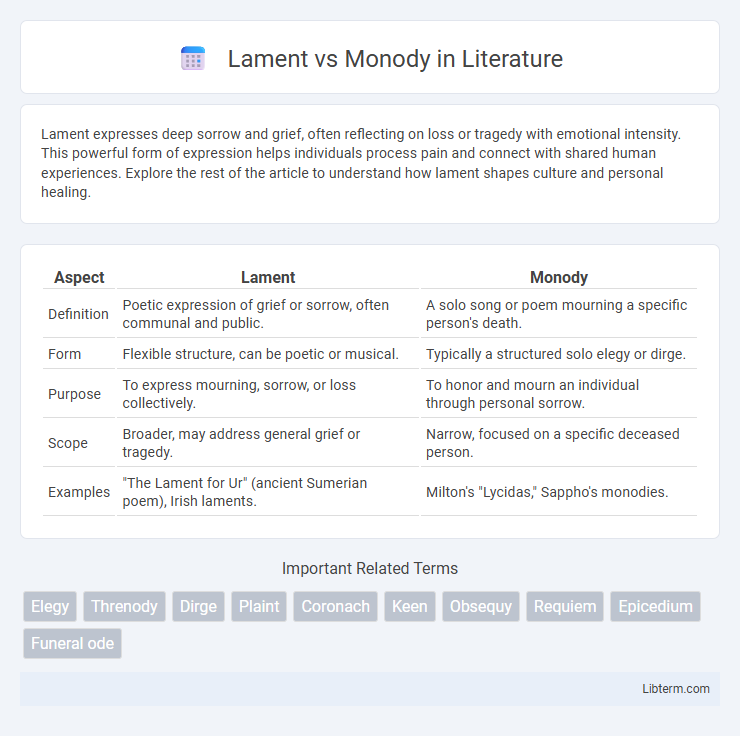Lament expresses deep sorrow and grief, often reflecting on loss or tragedy with emotional intensity. This powerful form of expression helps individuals process pain and connect with shared human experiences. Explore the rest of the article to understand how lament shapes culture and personal healing.
Table of Comparison
| Aspect | Lament | Monody |
|---|---|---|
| Definition | Poetic expression of grief or sorrow, often communal and public. | A solo song or poem mourning a specific person's death. |
| Form | Flexible structure, can be poetic or musical. | Typically a structured solo elegy or dirge. |
| Purpose | To express mourning, sorrow, or loss collectively. | To honor and mourn an individual through personal sorrow. |
| Scope | Broader, may address general grief or tragedy. | Narrow, focused on a specific deceased person. |
| Examples | "The Lament for Ur" (ancient Sumerian poem), Irish laments. | Milton's "Lycidas," Sappho's monodies. |
Understanding Lament: Definition and Origins
Lament is a poetic or musical expression of grief, sorrow, or mourning rooted in ancient oral traditions, often reflecting personal loss or communal tragedy. Originating in various cultures, laments serve as a cathartic outlet and a means to preserve collective memory through ritualized performance. Unlike monody, which emphasizes a single melodic line, laments encompass a broader range of emotional and narrative elements that articulate profound human suffering.
Monody Explained: Meaning and Historical Context
Monody refers to a single melodic line sung or played with instrumental accompaniment, emerging in early 17th-century Italy as a reaction against the complexity of Renaissance polyphony. This musical style emphasizes emotional expression and clarity of text, often found in early Baroque opera and solo madrigals. Monody laid the groundwork for the development of recitative and opera, playing a crucial role in the evolution of Western music history.
Key Differences Between Lament and Monody
Lament and monody differ primarily in their form and emotional expression; a lament is a broader poetic or musical expression of grief and mourning often involving collective or communal elements, while a monody is a solo vocal performance characterized by its melodic line that conveys personal sorrow. Laments frequently incorporate repetitive refrains and are rooted in traditional or ritualistic contexts, whereas monodies emphasize individual emotional depth through a singular melodic narrative. The key distinction lies in lament's communal, structured nature versus monody's intimate, expressive solo format.
The Emotional Depths of Lament in Literature
Lament in literature delves deeply into expressions of profound grief and sorrow, often giving voice to personal or communal loss through vivid, raw emotions. While a monody typically features a single speaker mourning a specific individual, a lament encompasses broader emotional landscapes, reflecting collective pain and existential despair. The emotional depth of lament is heightened by rich imagery, rhythmic repetition, and poignant language that evoke empathy and resonate with the human experience of mourning.
Musical Interpretations: Lament vs Monody
Lament and monody differ significantly in their musical interpretations, with laments often characterized by expressive, sorrowful melodies that emphasize emotional depth and mourning through slow tempos and minor keys. Monody, rooted in early Baroque music, focuses on a single vocal line accompanied by simple harmonies, highlighting clarity of text and expressive melodic contour to convey personal sorrow or reflection. While laments evoke communal grief or loss through rich, often repetitive motifs, monodies provide intimate, soloistic expression prioritizing lyrical delivery and ornamentation.
The Role of Lament in Cultural Expressions
Lament serves as a powerful cultural expression, encapsulating collective grief and providing a structured outlet for mourning and remembrance across societies. Unlike monody, which often emphasizes personal sorrow through solo poetic or musical performances, lament encompasses communal participation, rituals, and oral traditions that reinforce social bonds and cultural identity. This form of expression preserves historical memory while facilitating emotional healing within the community.
Monody in Classical and Modern Music
Monody in classical music refers to a solo vocal style characterized by expressive melody and clear textual delivery, prominently featured in early Baroque compositions such as those by Giulio Caccini and Claudio Monteverdi. This form emphasized emotional intensity and dramatic narrative, contrasting with the multi-voiced texture of madrigals. In modern music, monody influences singer-songwriter genres and contemporary classical works, where a single melodic line carries the emotional and lyrical content, often supported by minimalistic harmonic accompaniment.
Famous Examples of Laments Throughout History
Famous examples of laments throughout history include "Lament for Ur" from ancient Mesopotamia, expressing sorrow over the destruction of the city of Ur, and "Lament of the Irish Emigrant," which conveys deep grief over displacement. Monody, often characterized by a single melodic line expressing personal grief, is exemplified by John Dowland's "Flow My Tears," a celebrated English Renaissance piece. Both forms serve as poignant artistic expressions of mourning, reflecting cultural and historical contexts through their emotive storytelling.
Monody in Poetry and Song: A Comparative View
Monody in poetry and song is a solitary lament expressing personal grief, often characterized by a single voice mourning a loss with intimate emotion and direct address. Unlike broader laments that may involve collective or communal mourning, monodies emphasize individual sorrow and reflection, frequently structured as elegies or dirges. This focus on singular expression enhances emotional depth, making monody a powerful vehicle for personal narrative in both poetic and musical traditions.
Lament and Monody: Impact on Contemporary Art
Lament and monody both profoundly influence contemporary art by shaping expressive forms of grief and remembrance. Lament, characterized by collective mourning and cultural rituals, often inspires multimedia installations and performance art that evoke communal suffering. Monody's solo vocal tradition informs intimate artistic expressions, from spoken word to experimental music, emphasizing personal loss and solitude within modern creative practices.
Lament Infographic

 libterm.com
libterm.com